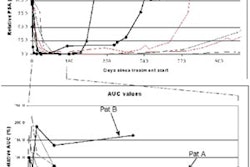Lippincott Williams & Wilkins, Philadelphia, 2001, $99.
When I first heard about this book, I expected a fundamental text that would be beneficial to a first- or second-year radiology resident who would read it once, maybe twice, during an initial ultrasound clerkship. To my pleasant surprise, The Core Curriculum: Ultrasound offers a wealth of information that will serve as a perpetual reference.
The book begins with a chapter on the performance of ultrasound and description of ultrasound artifacts. The remainder is organized by systems, including standard sections on abdomen, renal/adrenal, vascular ultrasound, the female pelvis, and small parts (scrotal and neck ultrasound).
There is no real discussion of ultrasound physics, so other sources will have to fill in the gap. But the book does discuss segments of ultrasound that rarely get enough attention. These topics include neonatal neurosonography, chest ultrasound, and ultrasound of organ transplant and TIPS patients.
There is also a chapter dedicated to prostate and seminal vesicle ultrasound, an area that has been almost taken over by urologists for image-guided prostate biopsy. Although it has gotten to the point where most imaging centers don’t even have endorectal ultrasound transducers on-site, it is still important to have at least a fundamental understanding of the anatomy and pathology of the prostate, seminal vesicles, and male bladder in general.
Each chapter covers vital topics such as transducer choice, acoustic windows, imaging pitfalls, timing of exams, and indications for specific studies. Descriptions and images of normal anatomy, as well as normal anatomic variants, follow. The author uses bullet points effectively to describe the disease states affecting each organ.
Another plus is the key pearls of information restated in the margins for easy reference. These pearls touch on very specific topics (for example, the management of follow-up ultrasound for benign-appearing ovarian cysts) as well as answer important basic questions (What is ventriculomegaly?).
There are also many beautiful pictures, including color images of normal anatomy and pathological states, which are invaluable. The tables that summarize key facts and the lists of differentials for specific imaging findings are especially helpful.
This text will be useful for anyone involved in the performance or interpretation of ultrasound. I came across information that would have easily answered the questions that I struggled with as a resident on call.
Ultrasound: The Core Curriculum presents essential information in an easy-to-read format and offers wonderful images to solidify the key concepts of this modality.
By Dr. David DanielsonAuntMinnie.com contributing writer
August 28, 2002
Dr. Danielson is a fourth year resident at Madigan Army Medical Center, Fort Lewis, WA.
If you are interested in reviewing a book, let us know at [email protected].
The opinions expressed in this review are those of the author, and do not necessarily reflect the views of AuntMinnie.com
Copyright © 2002 AuntMinnie.com



















